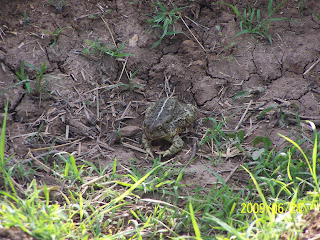Neighbors' Names...


Puttering around last night, we leaned against the garden fence at the back, admiring the basil--one plant in particular looks bushy and robust. I yelped, but didn't say anything. G scanned and re-scanned the garden nearby, before finally breaking out into a big grin. Toad - sighting number two. When we went in, I dug out my UNM Middle Rio Grande field guide (sorry, not the exact title). Woodhouse toad. Female bigger than the male. Primarily active at night. Mate in April.
Oklahoma Wildlife Department's Mike Mcallister says:
*The Woodhouse’s toad’s (Bufo woodhousii) name comes from Samuel Washington Woodhouse, a surgeon and naturalist who explored the southwestern U.S mid-19th century.
*This toad is a welcomed guest in lawns and gardens because it eats insects and slugs. A single toad can eat thousands of insects per year.
*Perfer sandy soil.
*All toads have enlarged glands, called the pararoid gland, on the side of the neck and behind each eye. These glands secrete a sticky white liquid that gets smeared in the mouth of any would-be predator. This substance inflames the mouth and throat. Humans should take care to wash their hands after handling a toad.
Wikipedia - originally native to the US and Mexico.
http://www.garden-city.org/zoo/animalinfo/ReptAmph/woodhouses_toad.htm
*Toes partly webbed.
*The eggs hatch in about one week, and the tadpoles develop into adults in 2-3 weeks. The young toads are [sexually] mature by 3 years of age. In captivity, they have lived up to 13 years.
Some individuals will consume as much as 2/3 of their body weight in insects each day.
*Adults only return to the water to breed. They do not lose water as quickly as other amphibians, and dew usually provides plenty of moisture for them. They can also survive higher temperatures than similar toads.
*Woodhouse's Toads secrete a chemical called Bufotoxin from their shoulder glands. This toxin is irritating to mucus membranes, and causes an increase in heart rate if it reaches the bloodstream. It can be fatal if swallowed in sufficient amounts.
*Hognose snakes specialize in eating toads, but few other predators can withstand the toxins that they produce.
eNature page has an audio file of their call. Ah hah--that's what is making the noise in the ditch across the street at dusk!
Northern Prairie Wildlife Research Center
[Very UR Toadly. grin.] They usually have a light line running middorsally down their back, but Woodhouse's Toad really doesn't have any distinguishing markings. So if you catch a toad that may be a Woodhouse's toad the best way to proceed is to first determine what it can't be. [It looks a lot like the American Toad and the Fowler's Toad.]
http://www.desertusa.com/mag99/aug/papr/wtoad.html
*One of the few suburbanities...
*Predators: raccoons, skunks, snakes, herons & fish who eat the tadpoles.
*Because they have microscopic mucous glands, which keeps their tight skin moist, Woodhouse's Toads may be seen away from water.
*Several subspecies (4).
- - - -
The dead wasp I found looks like a Steel-blue Cricket Hunter.
The red-brown dragonfly is probably a Flame Skimmer.
.


Comments